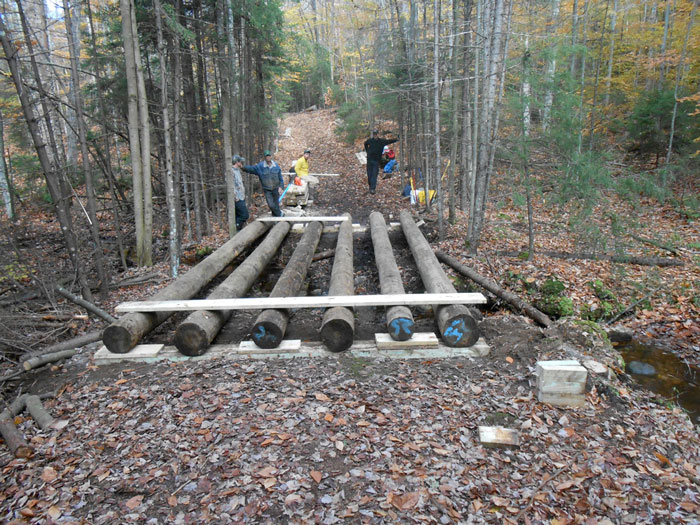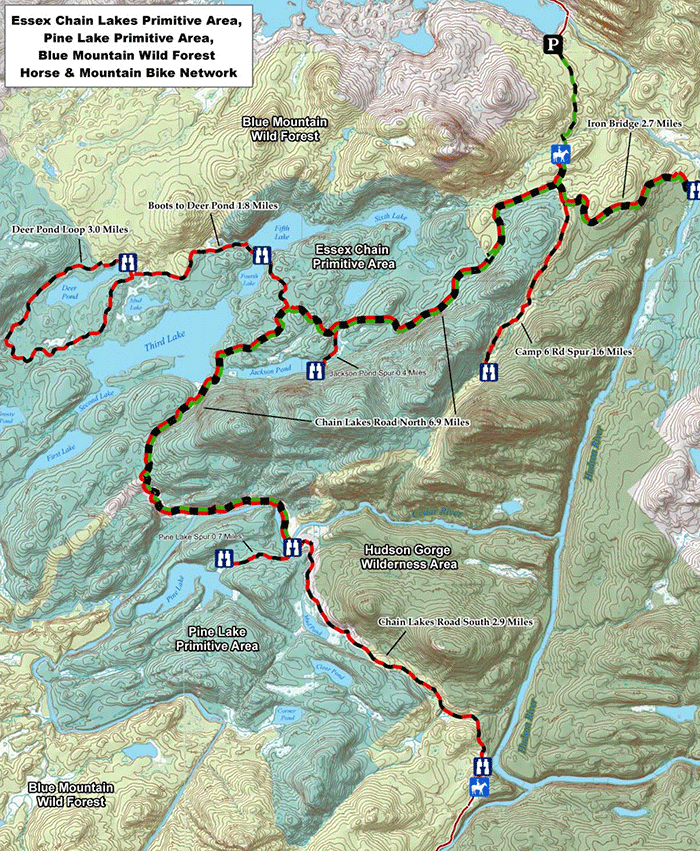The Adirondack Park Agency (APA) has committed to investigating potentially significant changes to the Adirondack Park State Land Master Plan (SLMP), which sets Forest Preserve management standards and guidelines. As part of the resolution passed by the APA in December 2013, two issues were identified for SLMP reform: 1) the requirement that bridges in Wild Forest areas be constructed with natural materials; 2) the prohibition of mountain biking on designated roads in Primitive Areas.
Last fall, the APA solicited public comments on these two items as well as any other issue that any member of the public desires to see changed in the SLMP. They then convened a group of stakeholders for a scoping meeting to share thoughts. The APA staff has not yet released draft recommendations for items to be officially considered for SLMP policy reform, and the APA Commissioners have not yet acted to start the public review process.
The APA is in its early stages of formulating a process and schedule for how to undertake SLMP reform and select issues. As they move ahead, they would be well served to adhere to the adage that good science makes good policy. The APA needs to bring solid data to the public about the issues they select for SLMP reform. We live in an age of stunning research and science, yet this is also an age where politics rather than science drive public policy. SLMP reform by anecdote is unacceptable.
Click here for a letter to the APA.
The issue of bridges on the Forest Preserve is important. The state is on record that it wants to build a 120 – 150-foot bridge across the Cedar River for a new motor vehicle route connecting Newcomb and Indian Lake. To span this width and hold the weight of a multi-ton snowmobile trail groomer, the Department of Environmental Conservation (DEC) needs to utilize non-natural materials. DEC uses many different kinds of bridges on hiking trails, roads, mountainbiking trails, and snowmobile trails in the Forest Preserve. Significant variations in bridge designs are used on snowmobile trails depending on whether a trail is a Class I or a Class II trail. Bridges vary significantly on hiking trails from long, narrow, steel-cable and wooden plank bridges to larger wooden beam bridges with railings on one or two sides, among other designs. Moreover, the DEC has informed the APA that engineering standards for public safety standards and for long-term resiliency have forced significant changes in bridge designs.

The APA should fully investigate and research the many different kinds of bridges used on the Forest Preserve when it considers changing the State Land Master Plan requirement that bridges be made of natural materials. Above is a snowmobile bridge under construction in the Moose River Plains.
The SLMP requirement that bridges in Wild Forest areas should be made of natural materials raises many questions. What types of bridges are currently used on foot trails? How do they perform? What types of bridges are used on snowmobile trails and how do they perform? What types of bridges are used on roads? What are the design standards referenced by the DEC that have changed bridge design? How have Forest Preserve bridges been impacted by extreme weather events? If changes are adopted, should they apply to other Forest Preserve classifications, not just Wild Forest? There are many others.
Clearly, the APA’s review of changes to the SLMP requirement for use of natural materials for bridges in Wild Forest areas would benefit from research and analysis of the effectiveness of current designs being utilized across the Forest Preserve and from a look at the state of the art in outdoor recreational bridge design on other public lands across the U.S.
The question of changing the rules for Primitive areas to allow mountainbike use also begs many questions. Primitive areas are those that possess Wilderness character, but contain some type of non-conforming use, such as a private road or power line, or it is too small to be a new Wilderness area, among other factors. The SLMP currently recommends that a great many Primitive areas should be upgraded to a Wilderness classification pending resolution of the non-conforming uses or further land acquisition. A few current Primitive areas will remain Primitive for the foreseeable future for a variety of reasons.

Should mountain biking be allowed on the former logging roads in the Essex Chain Lakes Primitive area?
Here, the APA should undertake research because it’s looking to change longstanding state policy based on a questionable premise. The APA is looking to change the Primitive classification so that mountainbikes can be used on a network of state administrative roads that will likely be maintained in the new Essex Chain Lakes Primitive area. The APA is looking to make this change based on unsubstantiated public comments that there is a great recreational interest in mountainbiking on these former logging roads.
Organized mountainbike groups are advocating effectively for new specially designed mountainbiking trail networks in various locations in the Forest Preserve based on the success of the Wilmington Wild Forest trail network. The DEC is now looking at 100 miles of new specially designed mountainbiking trail networks in the Moose River Plains. Mountainbike trail advocates are pushing for specially designed long distance trails that link the Wilmington Wild Forest trail network with other Forest Preserve areas.
The organized mountainbike groups have stated that they have little desire for mountainbiking trail systems on former logging roads. Desirable mountainbiking networks are based on single-track trails specially designed for biking. If there was a big public market for mountainbiking on former logging roads or dirt roads in general in the Adirondacks, why has mountainbiking not been a major activity in the Independence River Wild Forest, Black River Wild Forest, Moose River Plains Wild Forest (in the times outside the Black Fly Challenge race week), Ferris Lake Wild Forest, Watson’s East Triangle or Lake George Wild Forest areas? The market that exists for mountainbiking on dirt roads in the Essex Chain Lakes area is unproven and purely anecdotal, yet the APA is looking to make far-reaching changes to the Primitive area classification. Clearly research is needed.
Changes contemplated for Primitive areas could be substantial. Will the APA formalize the different types of Primitive areas? Will the APA formalize the two types of Primitive areas utilized in the SLMP? What is the mountainbiking market for riding on dirt roads? What is the mountainbiking use in other Forest Preserve areas outside of the Wilmington Wild Forest? What is the mountainbiking use near the Essex Chain Lakes area in Newcomb at the Santanoni Historic Area? Will the APA create an entirely new type of Primitive area? Will this new Wilderness-lite Primitive area mark the end of new or expanded Wilderness areas in the Adirondacks? Should mountainbiking be allowed in Wilderness areas? The issues are not simple and changes could be far-reaching. The APA would benefit from good research on these questions so that decisions are based on good data and not anecdote.
Beyond the issues of bridge materials and Primitive areas, many are advocating changes to the SLMP that could fundamentally change the way the Forest Preserve is managed. The APA has signaled a willingness to listen to all manner of recommended changes, both big and small. The APA will have to publish its intent for SLMP revision in the weeks ahead.
As the APA proceeds with SLMP revision, they would be well advised to follow the adage that good science makes good policy.
This article was also published as an op-ed in the Adirondack Almanack.





